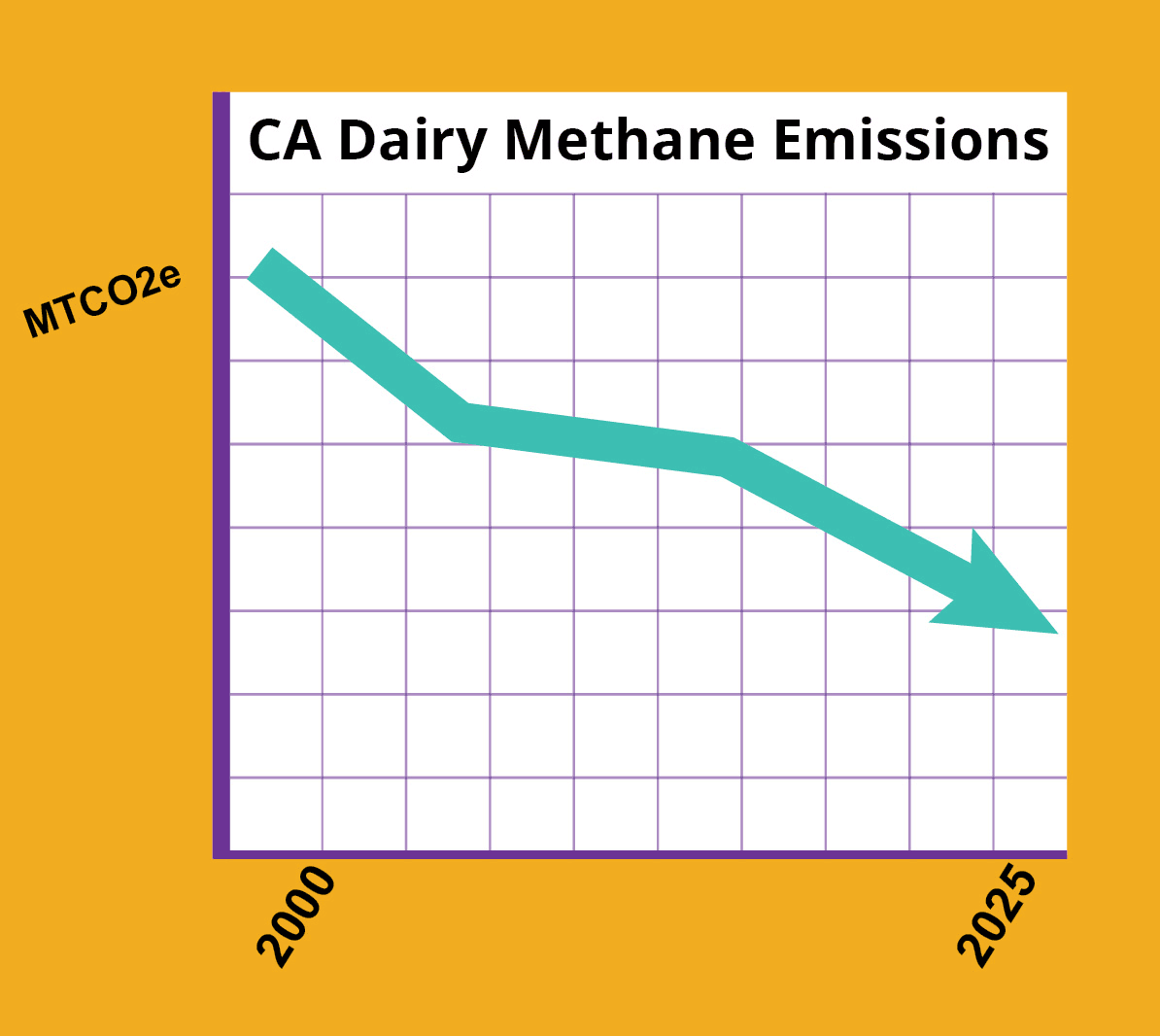
Climate scientists agree...
Reducing methane in the short term is the most critical path to slowing climate warming.
California Dairy Farms Deliver!
This year, the state’s dairy farms will achieve an annual reduction of 5 million metric tons of methane (5 MMTCO2e/year). This has been accomplished through on-farm projects to improve manure management and continuous gains in milk production efficiency, as the state’s dairy herd continues to shrink.
California’s dairy sector leads the nation in milk production, in addition to methane reduction efforts. Achieving 5-million-tons of annual reduction means the state’s family dairy farms are more than two-thirds of the way to delivering their share of California’s world-leading target: to reduce livestock methane emissions by 40 percent below 2013 levels by 2030. The state is the only jurisdiction with such a target set in statute, established by SB 1383, passed in 2016. Given methane’s powerful warming effect and short-lived nature, reducing methane is critical to near-term slowing of global warming.

California dairy farms have achieved methane reduction through several ongoing strategies:
-
Methane Capture and Utilization- California has 168 dairy digesters operating with about 75 more projects in development. Digesters capture methane from manure storage and put it to productive use as carbon-negative transportation fuel or other renewable energy needs. As projects under development come online, methane from manure will be captured from 270 dairy farms, creating either renewable electricity, renewable natural gas, or hydrogen fuel. Estimated total annual reductions from projects operating to date are 2.53 million MTCO2e. (Source: CDFA DDRDP)
-
Methane Avoidance- California dairy farms have implemented more than 128 alternative manure management projects, with another 65 projects funded and in development. Projects include manure separators, compost pack barns, manure scrape and vacuum systems, and other practices that avoid methane creation from manure management operations. Estimated total annual reductions from projects operating to date are 254,000 MTCO2e. (Source: CDFA AMMP)
-
Milk Production Efficiency/Herd Attrition- California dairy farms continue to shrink their environmental footprint by producing more milk (or consistent total milk volume) with fewer cows. Milk production efficiencies continue to be gained in many ways, including improved animal nutrition, selective breeding, and enhanced animal care and comfort. Overall, while total milk production has remained relatively stable, the number of dairy cows in California has continued to shrink, resulting in far fewer emissions. Estimated total annual reductions achieved to date (2013 to 2022) are 2.13 million MTCO2e. (Source: CARB California Dairy & Livestock Database)
Administered by California Department of Food and Agriculture (CDFA), livestock methane reduction efforts are supported through the Dairy Digester Research and Development Program (DDRDP) and the Alternative Manure Management Program (AMMP). A total of $356 million in grants has been made available since 2015. Incentive payments buy down the capital costs of methane reduction projects on farms. Project construction and maintenance is creating jobs and economic growth in rural, disadvantaged communities, while providing significant air quality benefits.
The total estimated dairy methane reductions are consistent with the following graph that California Air Resources Board presented in August 2024. CARB's estimated reductions demonstrate that state incentives are working and that additional funding is needed to achieve further reductions by 2030.

The state’s methane reduction programs are backed by investments from dairy farmers and other private financing. The DDRDP program requires at least 50 percent match per project. The AMMP encourages private matching dollars as well. To date, the DDRDP has leveraged more than $522 million dollars in private investment. The DDRDP is also the state’s second most productive climate program in terms of total greenhouse gas (GHG) reductions achieved. The DDRDP has achieved 20% of the GHG reductions from all of California’s climate investments combined, with just 1.5% of total funds awarded.
Additional funding is now needed as both the DDRDP and AMMP programs are significantly oversubscribed. Achieving the full 40% reduction in dairy methane emissions is within reach if additional funding can be made available to continue the state’s programs.
Notably, California dairy’s 5 million metric tons of annual methane reduction has been achieved alongside other important environmental advancements. Methane reduction projects provide significant direct and indirect air quality and public health benefits to communities in the San Joaquin Valley, while improving the protection of groundwater quality. Dairy farms are also creating renewal energy, while reducing their own reliance on fossil fuels.
Today, using digesters alone, California dairy farms are generating enough clean, renewable energy to fuel more than 17,000 vehicles daily. This comes from both the digester projects that create renewable natural gas (enough to fuel more than 3,500 transit buses) and the digester projects that create renewable electricity (enough to power more than 13,500 electric vehicles). This is in addition to the renewable energy generated by more than 175 solar arrays located on dairy farms across the state.
California dairy farmers are reaching ambitious, unparalleled climate goals while maintaining a strong local dairy sector and producing nutritious and affordable milk and dairy foods. The 5-million-ton annual reduction milestone is an important accomplishment and reminder of the need for continued partnership to ensure the long-term success and sustainability of California’s family farms.
Click Here Learn More About
California Dairy’s Comprehensive Methane Reduction Approach




